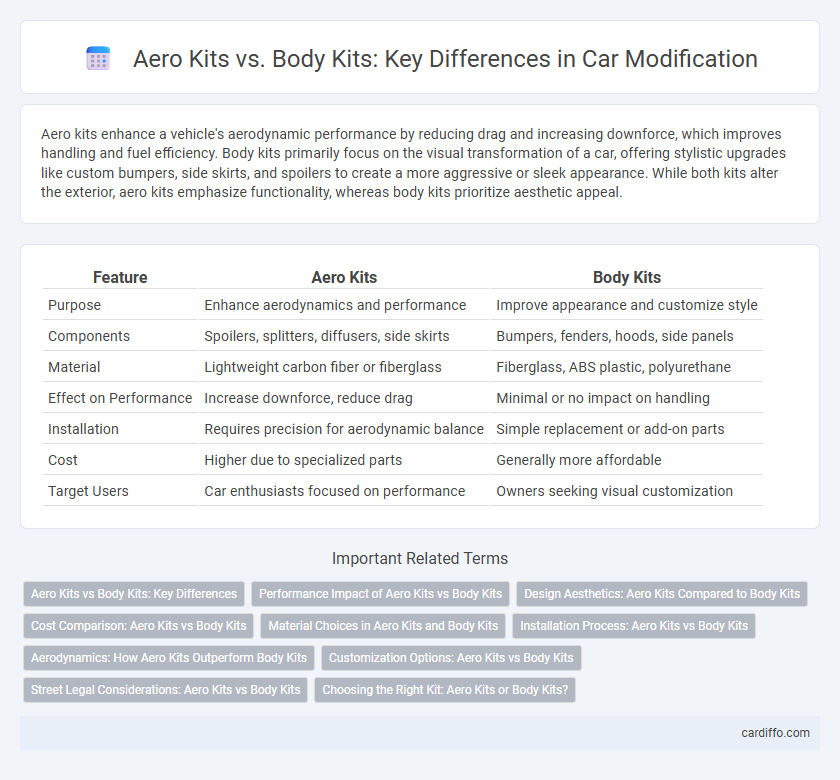Aero kits enhance a vehicle's aerodynamic performance by reducing drag and increasing downforce, which improves handling and fuel efficiency. Body kits primarily focus on the visual transformation of a car, offering stylistic upgrades like custom bumpers, side skirts, and spoilers to create a more aggressive or sleek appearance. While both kits alter the exterior, aero kits emphasize functionality, whereas body kits prioritize aesthetic appeal.
Table of Comparison
| Feature | Aero Kits | Body Kits |
|---|---|---|
| Purpose | Enhance aerodynamics and performance | Improve appearance and customize style |
| Components | Spoilers, splitters, diffusers, side skirts | Bumpers, fenders, hoods, side panels |
| Material | Lightweight carbon fiber or fiberglass | Fiberglass, ABS plastic, polyurethane |
| Effect on Performance | Increase downforce, reduce drag | Minimal or no impact on handling |
| Installation | Requires precision for aerodynamic balance | Simple replacement or add-on parts |
| Cost | Higher due to specialized parts | Generally more affordable |
| Target Users | Car enthusiasts focused on performance | Owners seeking visual customization |
Aero Kits vs Body Kits: Key Differences
Aero kits primarily enhance a vehicle's aerodynamic performance by optimizing airflow, reducing drag, and increasing downforce for improved stability and handling at high speeds. Body kits mainly focus on aesthetic modifications, altering the vehicle's exterior appearance with components such as bumpers, side skirts, and spoilers without significant aerodynamic benefits. The key difference lies in aero kits' functional design aimed at performance gains, while body kits emphasize visual style and customization.
Performance Impact of Aero Kits vs Body Kits
Aero kits are engineered to enhance vehicle performance by improving aerodynamics, increasing downforce, and reducing drag, which results in better stability and handling at high speeds. In contrast, body kits primarily focus on aesthetic modifications, often adding weight and providing minimal aerodynamic benefit, sometimes even compromising performance. Installing an aero kit can lead to measurable gains in lap times and fuel efficiency, whereas body kits mainly serve visual customization with negligible impact on driving dynamics.
Design Aesthetics: Aero Kits Compared to Body Kits
Aero kits enhance design aesthetics by improving aerodynamic efficiency with sleek, functional components such as splitters, diffusers, and side skirts that reduce drag and increase downforce. Body kits primarily focus on visual transformation, offering wider fenders, custom bumpers, and sculpted panels to create an aggressive, personalized look without necessarily optimizing airflow. Choosing an aero kit balances performance enhancements and subtle styling, while body kits emphasize standout visual impact and customization.
Cost Comparison: Aero Kits vs Body Kits
Aero kits generally cost more than body kits due to their advanced materials like carbon fiber and the complexity of aerodynamic engineering involved. Body kits, often made from fiberglass or polyurethane, provide a more affordable option for aesthetic modifications but lack the performance benefits of aero kits. Budget-conscious modifiers typically choose body kits, while enthusiasts seeking improved vehicle dynamics invest in the higher-priced aero kits.
Material Choices in Aero Kits and Body Kits
Aero kits commonly use lightweight materials such as carbon fiber and fiberglass to enhance aerodynamic performance and reduce overall vehicle weight. Body kits, while also employing fiberglass and polyurethane, often prioritize durability and ease of installation over weight savings. The choice of materials in aero kits directly influences downforce and handling, whereas body kits focus more on aesthetic enhancement and impact resistance.
Installation Process: Aero Kits vs Body Kits
Aero kits typically require precise alignment and mounting using factory-approved points, often necessitating professional installation to ensure optimal aerodynamic performance and structural integrity. Body kits involve more extensive modification, including cutting, sanding, and sometimes welding fiberglass or polyurethane components, demanding advanced skills and longer installation time. Choosing between the two depends on the installer's expertise and the desired balance between performance enhancement and aesthetic customization.
Aerodynamics: How Aero Kits Outperform Body Kits
Aero kits are specifically engineered to enhance a vehicle's aerodynamic efficiency by optimizing airflow, reducing drag, and increasing downforce during high-speed driving. Body kits primarily focus on aesthetics and may add weight or create turbulence, which can negatively impact aerodynamic performance. By integrating features like front splitters, rear diffusers, and side skirts, aero kits significantly improve stability and handling compared to traditional body kits.
Customization Options: Aero Kits vs Body Kits
Aero kits offer aerodynamic enhancements such as front splitters, side skirts, and rear diffusers designed primarily to improve vehicle performance and handling. Body kits provide extensive customization options by altering the car's visual style with full bumper replacements, wide fenders, and custom hoods to achieve a unique aesthetic. While aero kits focus on functionality and subtle design tweaks, body kits prioritize bold, transformative looks with a broader range of material and style variations.
Street Legal Considerations: Aero Kits vs Body Kits
Aero kits typically maintain street-legal compliance by using lightweight materials and adhering to manufacturer specifications for dimensions and safety standards. Body kits often involve more extensive modifications that can alter the vehicle's structure, potentially requiring inspections and certifications to remain street legal. Understanding local regulations and ensuring proper installation are crucial to avoid legal issues when choosing between aero kits and body kits for vehicle modifications.
Choosing the Right Kit: Aero Kits or Body Kits?
Choosing the right kit depends on your vehicle's purpose and aesthetic goals; aero kits enhance aerodynamic performance by reducing drag and increasing downforce, making them ideal for high-speed stability and racing applications. Body kits prioritize visual impact, offering customized panels and styling options that dramatically change the car's appearance without significant aerodynamic benefits. Evaluate driving needs, budget, and design preference carefully to select between performance-oriented aero kits and style-focused body kits.
Aero Kits vs Body Kits Infographic

 cardiffo.com
cardiffo.com